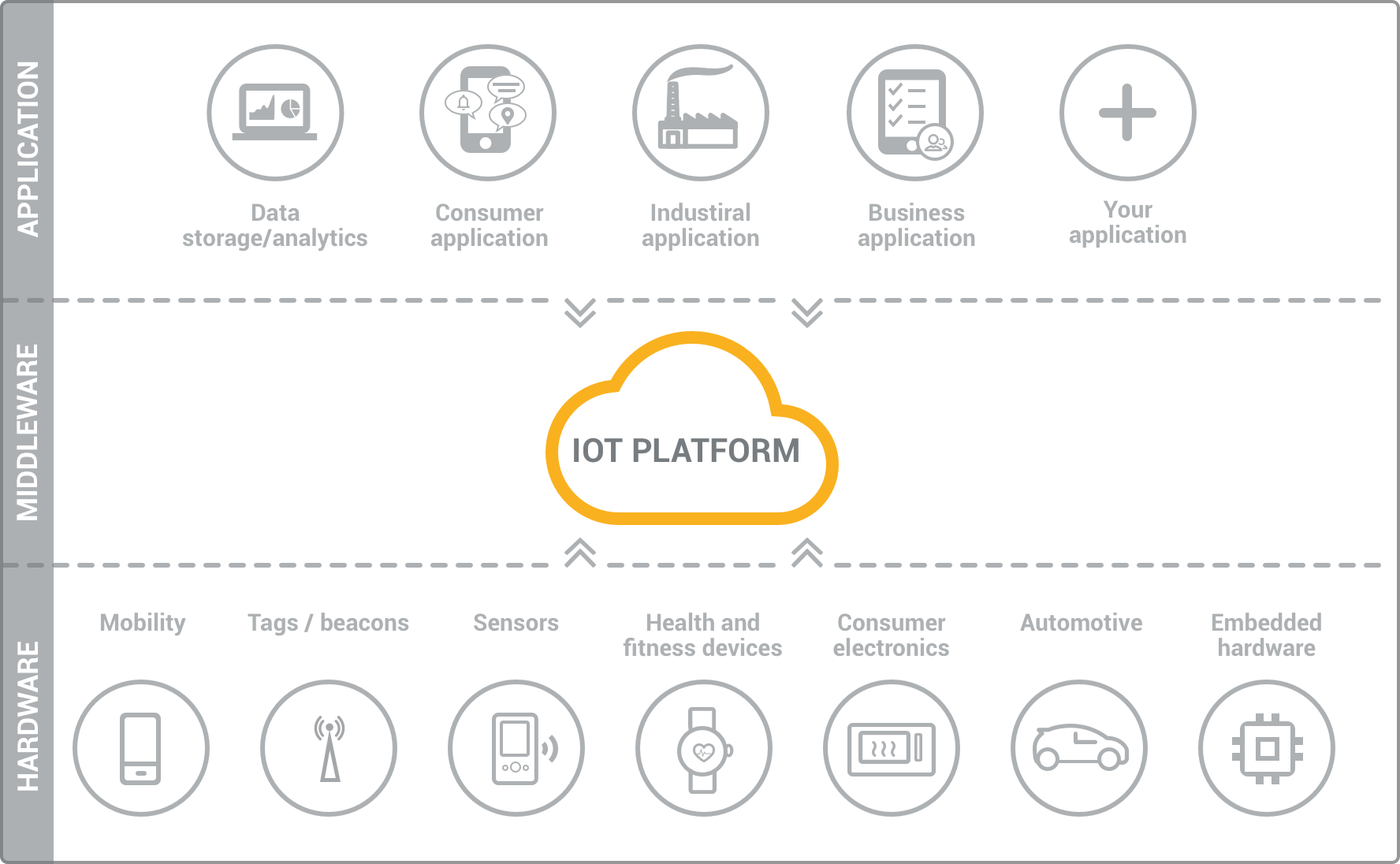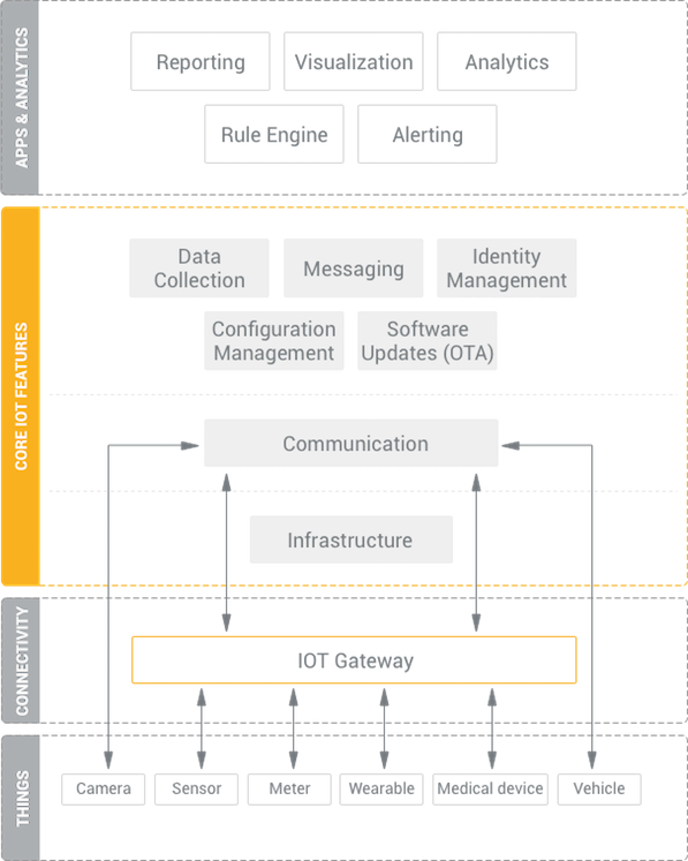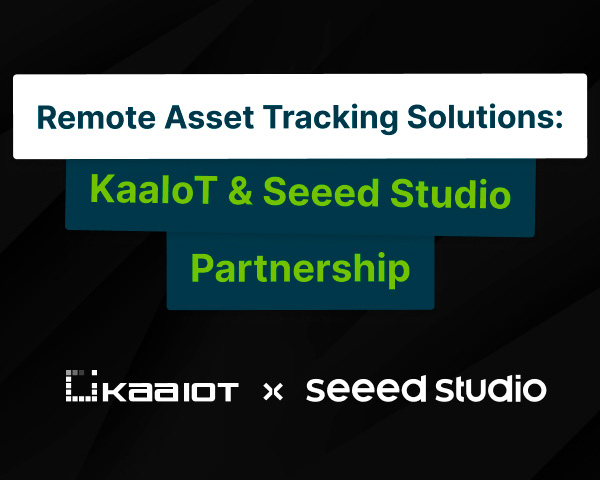What is an IoT platform?
An IoT platform is a multi-layer technology that enables straightforward provisioning, management, and automation of connected devices within the Internet of Things universe. It basically connects your hardware, however diverse, to the cloud by using flexible connectivity options, enterprise-grade security mechanisms, and broad data processing powers. For developers, an IoT platform provides a set of ready-to-use features that greatly speed up development of applications for connected devices as well as take care of scalability and cross-device compatibility.
Thus, an IoT platform can be wearing different hats depending on how you look at it. It is commonly referred to as middleware when we talk about how it connects remote devices to user applications (or other devices) and manages all the interactions between the hardware and the application layers. It is also known as a cloud enablement platform or IoT enablement platform to pinpoint its major business value, that is empowering standard devices with cloud-based applications and services. Finally, under the name of the IoT application enablement platform, it shifts the focus to being a key tool for IoT developers.
IoT platform as the middleware
IoT platforms originated in the form of IoT middleware, which purpose was to function as a mediator between the hardware and application layers. Its primary tasks included data collection from the devices over different protocols and network topologies, remote device configuration and control, device management, and over-the-air firmware updates.
To be used in real-life heterogeneous IoT ecosystems, IoT middleware is expected to support integration with almost any connected device and blend in with third-party applications used by the device. This independence from underlying hardware and overhanging software allows a single IoT platform to manage any kind of connected device in the same straightforward way.
 >
>
Modern IoT platforms go further and introduce a variety of valuable features into the hardware and application layers as well. They provide components for frontend and analytics, on-device data processing, and cloud-based deployment. Some of them can handle end-to-end IoT solution implementation from the ground up.
IoT platform technology stack
In the four typical layers of the IoT stack, which are things, connectivity, core IoT features, and applications & analytics, a top-of-the-range IoT platform should provide you with the majority of IoT functionality needed for developing your connected devices and smart things.
Your devices connect to the platform, which sits in the cloud or in your on-premises data center, either directly or by using an IoT gateway. A gateway comes useful whenever your endpoints aren’t capable of direct cloud communication or, for example, you need some computing power on edge. You can also use an IoT gateway to convert protocols, for example, when your endpoints are in LoRaWan network but you need them to communicate with the cloud over MQTT.
An IoT platform itself can be decomposed into several layers. At the bottom there is the infrastructure level, which is something that enables the functioning of the platform. You can find here components for container management, internal platform messaging, orchestration of IoT solution clusters, and others.
The communication layer enables messaging for the devices; in other words, this is where devices connect to the cloud to perform different operations.
The following layer represents core IoT features provided by the platform. Among the essential ones are data collection, device management, configuration management, messaging, and OTA software updates.
Sitting on top of core IoT features, there is another layer, which is less related to data exchange between devices but rather to processing of this data in the platform. There is reporting, which allows you to generate custom reports. There is visualization for data representation in user applications. Then, there are a rule engine, analytics, and alerting for notifying you about any anomalies detected in your IoT solution.
Importantly, the best IoT platforms allow you to add your own industry-specific components and third-party applications. Without such flexibility adapting an IoT platform for a particular business scenario could bear significant extra cost and delay the solution delivery indefinitely.
Advanced IoT platforms
There are some other important criteria that differentiate IoT platforms between each other, such as scalability, customizability, ease of use, code control, integration with 3rd party software, deployment options, and the data security level.
- Scalable (cloud native) – advanced IoT platforms ensure elastic scalability across any number of endpoints that the client may require. This capability is taken for granted for public cloud deployments but it should be specifically put to the test in case of an on-premises deployment, including the platform’s load balancing capabilities for maximized performance of the server cluster.
- Customizable – a crucial factor for the speed of delivery. It closely relates to flexibility of integration APIs, louse coupling of the platform’s components, and source code transparency. For small-scale, undemanding IoT solutions good APIs may be enough to fly, while feature-rich, rapidly evolving IoT ecosystems usually require developers to have a greater degree of control over the entire system, its source code, integration interfaces, deployment options, data schemas, connectivity and security mechanisms, etc.
- Secure – data security involves encryption, comprehensive identity management, and flexible deployment. End-to-end data flow encryption, including data at rest, device authentication, user access rights management, and private cloud infrastructure for sensitive data – this is the basics of how to avoid potentially compromising breaches in your IoT solution.
Cutting across these aspects, there are two different paradigms of IoT solution cluster deployment offered by IoT platform providers: a public cloud IoT PaaS and a self-hosted private IoT cloud.
IoT cloud enablement
An IoT cloud is a pinnacle of the IoT platforms evolution. Sometimes these two terms are used interchangeably, in which case the system at hand is typically an IoT platform-as-a-service (PaaS). This type of solution allows you to rent cloud infrastructure and an IoT platform all from a single technology provider. Also, there might be ready-to-use IoT solutions (IoT cloud services) offered by the provider, built and hosted on its infrastructure.
However, one important capability of a modern IoT platform consists in a private IoT cloud enablement. As opposed to public PaaS solutions located at a provider’s cloud, a private IoT cloud can be hosted on any cloud infrastructure, including a private data center. This type of deployment offers much greater control over the new features development, customization, and third-party integrations. It is also advocated for stringent data security and performance requirements.
What your business can do with an IoT platform

An IoT platform plays a pivotal role for smart device vendors and startups, who can use it to equip their products with remote control and real-time monitoring functions, configurable alerts and notifications, pluggable cloud services, and integration with consumers’ smartphones and other devices.

Another broad application of the IoT platform is cost optimization for companies in the industrial, agriculture, and transportation sectors through remote monitoring of devices and vehicles, predictive maintenance of equipment, collecting sensor data for real-time production analytics and ensuring safety, and end-to-end cargo delivery tracking.
 Large-scale IoT clouds are typical solutions for CSPs, smart city and smart energy integrators. By using an IoT platform, these companies develop IoT infrastructures for delivering all kinds of new services for regular customers, public service companies, and giant corporations. Among them are connected car services, smart grid metering, city-wide air quality monitoring, smart building deployments, and numerous others.
Large-scale IoT clouds are typical solutions for CSPs, smart city and smart energy integrators. By using an IoT platform, these companies develop IoT infrastructures for delivering all kinds of new services for regular customers, public service companies, and giant corporations. Among them are connected car services, smart grid metering, city-wide air quality monitoring, smart building deployments, and numerous others.
 Finally, an IoT platform is the essential technology for improving customer experience in retail, healthcare, hospitality, and travelling domains. It is used to enable highly personalized services and ensure stress-free interaction between the customer and the company. A case in point is remote patient monitoring and treatment solutions, which are incredibly convenient to use and save a person much time on regular visits to the hospital. Collecting thorough patient data becomes effortless with the IoT, whereas retailers and hospitality companies use rich data collection to create personal offerings and run effective marketing.
Finally, an IoT platform is the essential technology for improving customer experience in retail, healthcare, hospitality, and travelling domains. It is used to enable highly personalized services and ensure stress-free interaction between the customer and the company. A case in point is remote patient monitoring and treatment solutions, which are incredibly convenient to use and save a person much time on regular visits to the hospital. Collecting thorough patient data becomes effortless with the IoT, whereas retailers and hospitality companies use rich data collection to create personal offerings and run effective marketing.
Strategic trends for IoT platforms
As Gartner pointed out in their technology forecast for 2018, the next generation of business ecosystems will be increasingly more digital, intelligent, and connected. The IoT plays a pivotal role in what they call “an intelligent digital mesh”, thus setting a higher bar for modern IoT platforms in several areas.
- Digital twins – offer a more powerful way to monitor, control, and manage assets. Digital twins provide a comprehensive digital representation of real-world devices and systems, thus improving their state monitoring and enabling faster responses to external and internal events. Implementation of digital twins require IoT platforms to provide a highly flexible device management capabilities, which could cope with any level of sophistication depending on the use case. The applications of digital twins vary widely from asset inventory and predictive maintenance to event simulation and usage analytics. In the nearest future they are expected to become a keystone of every efficient IoT ecosystem.
- Intelligent things – utilize AI and machine learning to extract more insights from collected data and optimize their interactions within an IoT ecosystem. As basic IoT use cases have been successfully gaining ground, further enhancement offered by AI will galvanize even greater progress. Autonomous vehicles and robots at manufacturing facilities maximize production and delivery speed while unparalleled surveillance capacity provided by AI-supported security cameras radically transforms criminal-justice systems. The examples are many in every sector of economy. To allow for these cutting-edge solutions, IoT platforms must be designed to support flexible integration with AI systems and offer scalable, resilient device orchestration.
- Cloud to the edge – places computing and data processing powers closer to managed entities in an IoT ecosystem. The combination of cloud and edge computing architectures enables all the benefits of a flexible cloud-native model, where separate services can be managed and distributed across connected assets in a scalable manner, while at the same time ensure effective operation of disconnected entities and allow them take faster actions in response to new data. Considering other related tasks in regard to cluster management in private cloud and multicloud environments, it is clear that an IoT platform have grown out of being a mere development tool and should be capable of handling DevOps as effectively.
Connecting the dots
IoT solutions are getting inevitably more complex and dynamic. They involve larger ecosystems of devices and evolve much faster than traditional enterprise application software. With the proliferation of all types of remote interactions between devices and humans, IoT solutions are also spearheading a new paradigm for customer-oriented digital experience. Their complexity may seem intimidating at first but, in fact, taking advantage of the IoT is feasible at a fraction of the usual effort and without reinventing the wheel. For this purpose, an IoT platform is the new wheel.







